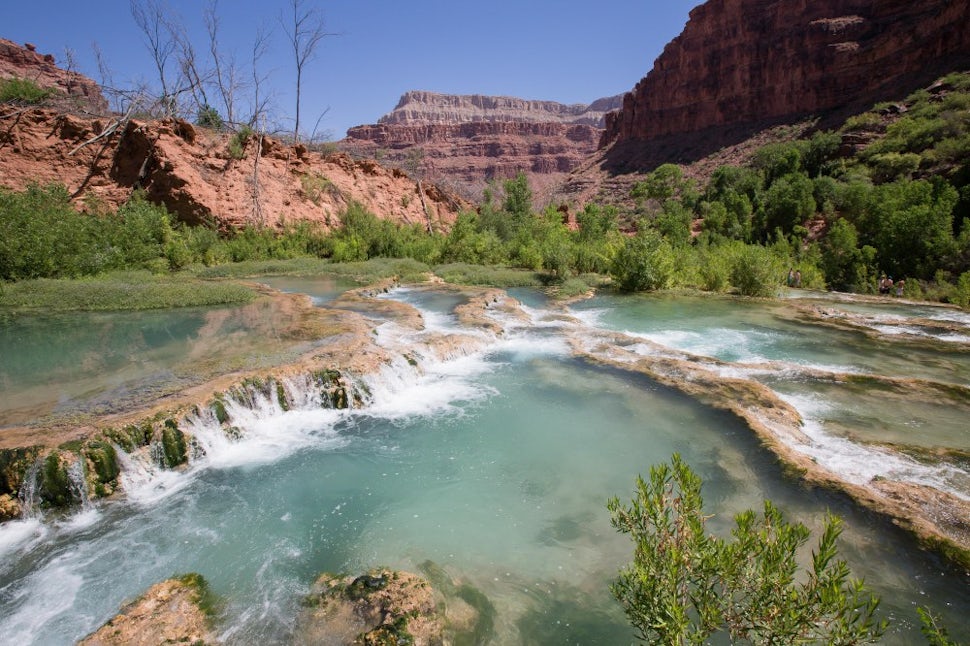A Waterfall Wonderland Hidden in Havasu Canyon
Why go guided? I will explain by sharing my Havasupai hiking experience with Arizona Outback Adventures (AOA).

After driving through the land of the Haulapai Indians, characterized by the lanky pine trees filling the emptiness of the desert and longhorn cattle grazing just feet from the roadway, our guide AJ pointed out the window at two California condors gliding overhead. We had reached the end of Hilltop Road and the beginning of Havasu Canyon in Arizona, greeted by these massive birds that were nearly extinct three decades ago.
Standing on the edge of the vast canyon, we soaked in the enormous view and marveled at how tiny the hikers below appeared. Looking down at the ancient layers of tan and red rock, we spotted a train of mules navigating the switchbacks. A Havasupai man on horseback was leading the way with his trusty comrade, a black and tan dog, obediently tagging along.

After lunch, we began our journey to Supai and its desert oasis, backpacks filled with three liters of water on the 110-degree day and the bare minimum to live in the canyon for four days.
Our guides, Jim and AJ, of Arizona Outback Adventures, led 15 of us on what was unanimously one of the wildest and best adventures of our lives. Jim and AJ, who are adventurous to the core, shared their love and knowledge of the wilderness with us all. They inspired us to challenge ourselves physically and discover and respect the geology, history, wildlife and culture that make Havasu Canyon so different from any other place on the planet.

Our group immediately bonded and by the time we made it into the canyon, we became the self-dubbed Chocopai Tribe.

Supai is the most remote town in the lower 48, one of the only places where mail is still delivered by mules and home to the Havasupai Native American Indian Tribe (they are closely related to the Haulapai Indians mentioned earlier). Just two miles further is a campground in a desert wonderland cascading with blue-green waterfalls, a vast field of wild grapes reminiscent of the Jurassic Era, an old mining cave and wild places to explore around every bend of the canyon.

About 7 miles in, when we reached a large boulder with dozens of pockets holding smaller rocks, we were told to find a rock to add to the collection to mark our official entrance. We would remove this rock at the end of our stay on the hike out.
In the village of Supai, we passed a school, churches, small southwestern cottages, a mom pushing her daughter in a stroller, horses grazing, a young boy splashing in a tributary in the shade, clothes on the line, a bicycle laying in the front yard–life at a slower pace.

Less than a mile before the campground, we reached Havasu Falls. Immediately, we dropped our backpacks to walk into the refreshing water immersing ourselves in the scenery. The turquoise waters of Havasu, rich in magnesium and calcium minerals, reflect the sunlight giving it a blue-green hue deserving of its own name in a pack of Crayolas.

When we reached camp, our tents had already been set up and AJ and Jim cooked an awesome dinner.
For the next two days, we hiked, crossed creeks, leaped into waterfalls, experienced true darkness in a mining cave, got shot out of a hurricane, hung out in a secret green room behind travertine rock formations, swung on ropes, climbed the side of Havasu to jump in, fell asleep under trillions of stars to the sounds of rushing water, saw an orangey-red tanager bird, ate the best camping food ever, looked for (and found) fossils, and went stargazing at Havasu Falls before bed.

I knew I was going to love Havasu, but our adventure was 1,000 times grander than I ever imagined it could be thanks to the amazing people we shared it with and our guides who went above and beyond to show us the secrets of Havasu, bandage our blisters, make us laugh and keep us safe.

We want to acknowledge and thank the past, present, and future generations of all Native Nations and Indigenous Peoples whose ancestral lands we travel, explore, and play on. Always practice Leave No Trace ethics on your adventures and follow local regulations. Please explore responsibly!
Do you love the outdoors?
Yep, us too. That's why we send you the best local adventures, stories, and expert advice, right to your inbox.







